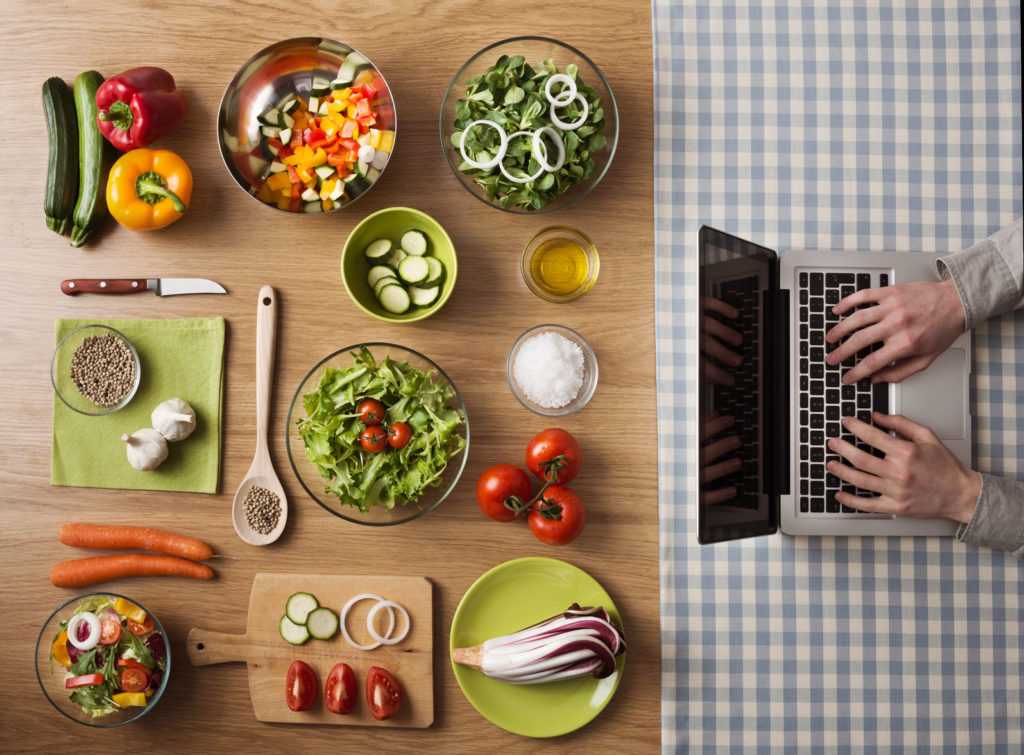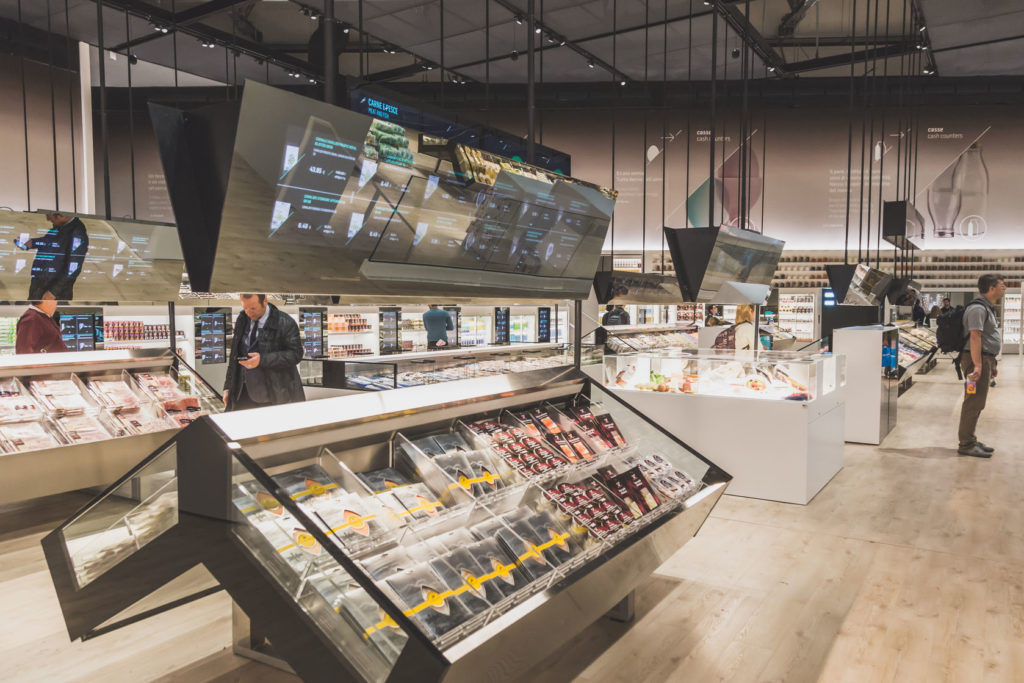Consumers are becoming increasingly demanding when it comes to food. According to the ANIA (French National Food Industry Federation)/Opinion Way Barometer 2015, food expenses are where French people least want to cut corners. They are also paying more attention to the quality of what they eat: ingredients and nutritional value went up 18 and 4 points respectively in the selection criteria ranking compared to 2013. This was at the expense of price and use-by dates, which went down 7 and 13 points respectively in comparison with 2013. According to the CSA Research survey for Agence Bio published in January 2017, 83% of French people trust organic products. More are consuming organic products on a daily basis (10% in 2015; 15% in 2016).
Supermarkets have already reacted by installing stalls selling cheese, meat, fish and bread to humanise the shopping experience. Fruit and vegetable sections have also been updated with mist machines and explanatory information for quality and freshness purposes.
However, supermarkets are also having to cope with a rise in alternative approaches being taken by consumers shopping organic…
1 – The supermarkets’ problem
According to a 2017 UFC-Que Choisir study, supermarkets are facing a range of problems to do with organic produce.
- Researchers found supermarkets have much higher margins (+96%). This means organic foods are 79% more expensive than their conventional equivalents.
– Less organic choice: for example, 43% of the time it is impossible to find conventional and organic tomatoes and apples in the same store. In 23% of cases neither product can be bought organic.
2 – Customer/consumer expectations
Households say they eat organic for health reasons (66%), for environmental reasons (58%) and for quality and taste (56%). (CSA Research for Agence Bio//January 2017). They want GM-free products without artificial flavours and colours checked to meet precise specifications and guaranteed as well as proof that no animals are harmed in their making.
3 – Service positioning (technological tools and what they offer)
As well as AMAPs (consumer networks helping local farmers by committing to buy fruit and vegetable boxes ahead of time), more transparent services requiring less commitment are emerging.
“Passive” apps let users locate those selling organic products and offer a full service including delivery. This alternative approach is being set up to satisfy different types of organic consumer.
![]() La Bio en Poche is an app which shows users places near them selling organic products (shops, markets, restaurants, AMAPs, etc.) using the geolocation function on their phones. In addition to offering geolocation, the app also suggests recipes, has fun and educational content and the latest organic news.
La Bio en Poche is an app which shows users places near them selling organic products (shops, markets, restaurants, AMAPs, etc.) using the geolocation function on their phones. In addition to offering geolocation, the app also suggests recipes, has fun and educational content and the latest organic news.
![]() La Ruche qui dit Oui ! : every week subscribers can order products on sale from partner producers. The order is delivered during the week to their local Assembly venue.
La Ruche qui dit Oui ! : every week subscribers can order products on sale from partner producers. The order is delivered during the week to their local Assembly venue.
![]() Bienvenue à la ferme is the main direct sales network for farm produce and tourism. Product sales, restaurants, fun activities and stays on the farm: all this and more lets consumers learn more about organic food in France.
Bienvenue à la ferme is the main direct sales network for farm produce and tourism. Product sales, restaurants, fun activities and stays on the farm: all this and more lets consumers learn more about organic food in France.
![]() Marchés des Producteurs de Pays is a Chambers of Agriculture brand. These markets bring together local producers committed to following a good practice charter which guarantees consumers:
Marchés des Producteurs de Pays is a Chambers of Agriculture brand. These markets bring together local producers committed to following a good practice charter which guarantees consumers:
– high-quality produce
– local and seasonal produce and specialities of the country
– high-quality production and processing methods
– direct contact with producers
– transparent farming practices
Markets can be regular, seasonal or one-offs and all highlight the richness and diversity of our produce, enabling consumers to purchase the best local products direct.
![]() Mon-marche.fr offers the widest selection of premium fresh products alongside useful information and excellent service.
Mon-marche.fr offers the widest selection of premium fresh products alongside useful information and excellent service.
Consumers can shop online with 60 traders at Rungis International Market in Paris and have their orders delivered.
![]() Baladovore Baladovore lets users find their location and the growers and organic products nearest them. You can use the app to look at their products and find what you are interested in without having to travel.
Baladovore Baladovore lets users find their location and the growers and organic products nearest them. You can use the app to look at their products and find what you are interested in without having to travel.
4 – How can supermarkets respond?
Some supermarkets have already brought in solutions to support this change in the way we shop and eat. Here are two interesting examples taken from retail:
Coop Italy: An interactive experience for transparency and education.
The Italian retailer has installed interactive mirrors which provide information about the fruit and vegetables in its supermarceto del futuro in Milan: traceability, best season for consumption, menu ideas, etc. This adds value to the service and provides consumers with everything they need to feel reassured.
McDonald’s: Education and partnerships with official certifications to reassure consumers.
As shown in recent marketing campaigns, the brand is trying to communicate its involvement with local organic producers to reassure consumers about product quality. Featuring official certifications in adverts reassures the consumer that the brand is being truthful and offering quality products.
https://www.youtube.com/watch?v=bJLOdGPUON0
Carrefour joins the fight for wider crop variety.
In its “Forbidden Market” campaign, the brand squares up to the law forbidding the sale of certain varieties of produce. The brand positions itself as committed to and fighting for better consumption.
(The advert is noticeably similar to the one from McDonald’s: we are now seeing the conversation around organic products being institutionalised by mass-market stakeholders.)
Although these responses to the organic “crisis” in the mass-market are contextual examples which deal with companies’ own issues, we must also consider inviting consumers to reflect on possible solutions in order to understand what holds them back, motivates them and the ways in which they use products. When it comes to the “purchase” stage of the consumption cycle, it’s all about usage. By making an effort to develop solutions consistent with consumer usage, the transition to new ways of shopping and eating will occur more smoothly and leading positions can be pre-empted as offers and services will be in line with consumer expectations.
By Sidney Debaque
Strategic planner Cosmic Agency


